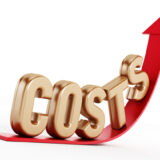President Trump’s economic report slams fuel taxes, recommends user fees instead
President Donald Trump’s infrastructure plan expects to generate approximately $1.5 billion in funding by making available only $200 billion in federal spending. But how? The Economic Report of the President released earlier this week offers more insight to the thought process of the White House regarding infrastructure funding, including such ideas already tossed around as tolls and public-private partnerships.
Released every February, the Economic Report of the President is published by the president’s Council of Economic Advisers. The reports reviews the impact of economic activity the previous year and establishes economic goals for the year ahead. Trump’s report includes a section devoted to funding and financing needed for infrastructure.
Fuel taxes
Although President Trump has recently showed interest in a possible fuel tax increase, the report takes on a different tone. More specifically, fuel taxes are shown to be outdated and inefficient.
The report calls fuel taxes “imperfect because they fail to encourage efficient use of existing roadways.” Highly fuel-efficient vehicles pay less in road use in terms of wear and tear, congestion and other external costs.
When it comes to trucks, the report was less than friendly.
“Evidence suggests that heavy trucks in particular do not currently face taxes and charges that are aligned with the negative externalities they generate, which include pavement damage, traffic congestion, accident risk, and emissions,” the reports says.
According to the report, only 26 states have increased their fuel taxes in the past four years.
User taxes
Trump’s report had more kind words to say about user fees, such as vehicle miles traveled (VMT) taxes. In fact, the report suggests replacing fuel taxes with a mileage tax.
“One innovative approach is to consider supplementing or replacing fuel taxes altogether with a user fee more closely related to a consumer’s use of the system—such as, in the present context, a tax on vehicle miles traveled.”
One suggestion is to have a VMT pay structure that varies with the time of day, region of use and vehicle weight. To the latter variable, the report makes an argument for VMT taxes on commercial trucks, but with a catch: an additional diesel tax increase.
“A VMT tax on commercial trucks would decrease external costs by $2.1 billion and raise $43 billion in tax revenues; including vehicle weight as a factor in the tax and raising diesel taxes in tandem would achieve similar efficiencies but generate revenues of nearly $70 billion annually.”
Higher VMT taxes in urban areas than in rural area also is suggested. The report argues that congestion and accidents are higher in urban areas, thereby justifying the increased VMT tax by forcing motorists to drive fewer miles on urban roadways.
Furthermore, the report claims that VMT taxes negatively affect high-income drivers more than low-income drivers. The thinking here is that high-income earners are more likely to live in urban areas and to own more fuel-efficient vehicles.
Just like fuel taxes, Trump’s report was less favorable to truckers. In the case of user fees, the report referred to states that impose alternative taxes on heavy vehicles with weight-distance or ton-mile taxes as potential sources for more efficient revenue.
The president’s report cited examples in Switzerland and Germany as well. In Switzerland, a distance-based charge system was installed for only heavy commercial vehicles in response to traffic, wear and tear, and emissions. Fees ranged from $0.90 to $1.27 per mile. In Germany, heavy commercial vehicles are charged by distance on its main highways.
“Some empirical evidence suggests that the introduction of the charge in 2005 was followed by improved efficiency, as shippers adjusted by routing fewer empty trucks and by loading trucks up to their maximum allowable weight,” the report said.
The report concluded infrastructure funding needs with a large nod to user fees:
“More generally, governments should be encouraged to generate needed revenues from user charges on those who benefit from publicly provided roads, water facilities, and other infrastructure.”
Tolls
The report said that state and local funding for roads and highways use a “two-part tariff system of quasi user fees.” Annual vehicle registration fees and license fees are fixed and do not depend on road use. On the other hand, fuel taxes and tools collect money based on use levels. The latter revenue source can affect driving behavior by discouraging miles traveled, opening up congestion and lessening wear and tear.
A case was made for tolls by pointing out that toll revenue accounted for only 6 percent of total spending on roads and highways.
“The economic arguments in favor of using toll revenues to pay for roads and highways are solid,” the report said. “By collecting fees from the direct users of the assets (motorists, commercial carriers, et al.), governments acquire revenues needed to maintain, operate, rehabilitate, and expand the roads, and drivers use the roads up to the point at which their marginal benefits equal the marginal costs they impose when driving.”
In other words, tolls force drivers to calculate how much their time and travel is worth. Although the report acknowledges that low-income drivers may be priced out of toll lanes, it also states that “evidence suggests that at least some low-income drivers in practice find tolled lanes worth paying for.” As long as high-income drivers use the highway during rush hour, time-varying tolls will “raise welfare” for drivers on both tolled and not-tolled segments.
Public-private partnerships
Lastly, public-private partnerships (P3s) were cited as an “innovative and efficient, though not free, procurement of infrastructure projects.”
Stating its case, the report suggests that traditional appropriations give private contractors little incentive to complete projects in a timely and cost-efficient manner. Since private partners are responsible for a bulk of the projects and risks, the reports argues, then P3s will have more incentive to be more efficient throughout the process.
The report does highlight that P3s are uncommon in the United States. According to a U.S. House of Representatives Transportation and Infrastructure Committee report, P3s account for only 1.5 percent of highway spending between 1989 and 2013. Only 34 states and the District of Columbia have statutes that allow the use of P3s for transportation infrastructure.









